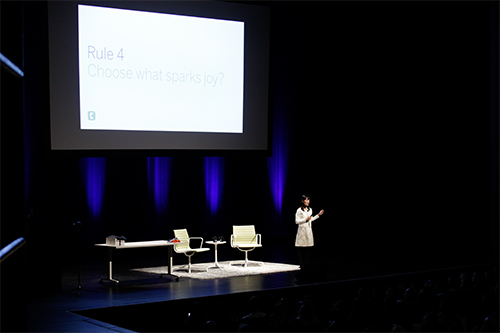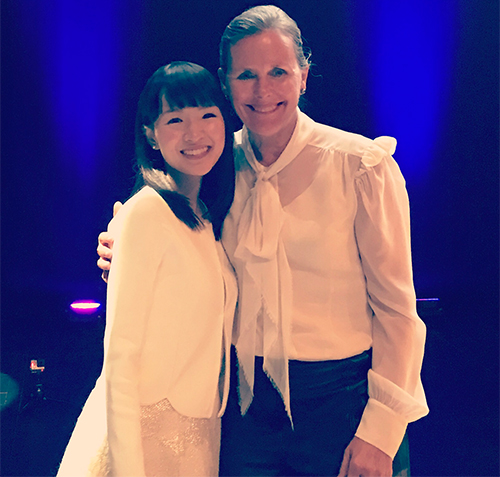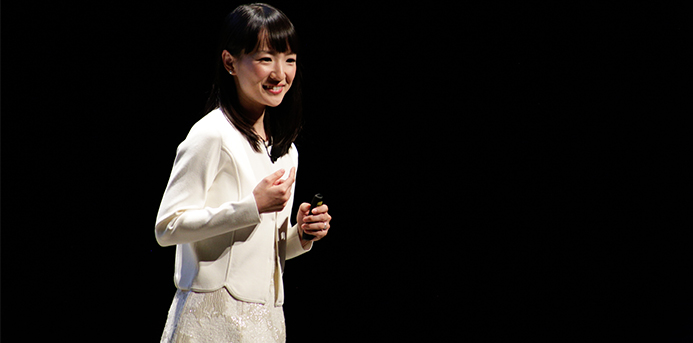Marie Kondo opened her 2017 Chicago Humanities Festival program with a simple question: “Is your home tidy?”
After the laughter died down, she calmly assured everyone, “Don’t worry, I can help you.”
Kondo has been doing exactly that with her best-selling books, “The Life-Changing Magic of Tidying Up” and “Spark Joy.” She says her love of order started when she was a child. “I tidied up every place I’d go. I started in my room, then the next day my brother’s room, then my sister’s, the kitchen, the living room, the rooms of friends then more friends and back to my room.”
Even with all of that cleaning and clearing, Kondo asserts that she’s not a minimalist. Her principles — which she calls the KonMari Method — don’t adhere to a “less is more” philosophy but instead encourage the keeping of items, as long as they spark joy. She says, “In my home, I’m surrounded by my favorite things, including 15 pairs of chopstick rests.”
Kondo explains the KonMari Method in four (seemingly) simple steps:
1. Imagine Your Ideal Life
This pre-work is imperative. Consider why you want to tidy and define your ideal lifestyle. “Be specific,” Kondo urges. She gives an example of a client who longed for an all-white space as neat as a hotel room with spots for doing yoga, drinking camomile tea and listening to classical music. The vision engages all of the senses. Kondo says that setting a specific final goal will motivate you during the tidying process.
2. Tidy in One Go
Fifteens minutes here and 15 minutes there won’t work for long-term change. “Tidying is a special event,” Kondo says. Accordingly, set a deadline. Then promise yourself that you’ll never go back to the mess again.
Tidy all at once, even if the items aren’t physical. Go through digital files and photographs in one go to determine what to keep and the appropriate storage folders for easy retrieval. This type of tight turnaround, Kondo says, “Shocks your mindset and changes it completely to help you become a more organized person.”
3. Tidy by Category, Not by Location
For example, gather all of your clothes into a pile. “I mean everything — the clothes in your house including from your bedroom, dresser, coat closet, maybe even your car,” Kondo says. By grouping all like items you’ll get an idea what you have and might even be shocked by how much you actually own. Kondo cites one client who didn’t realize how many teacups she had until they put them all together — there were 200!
This principle extends even to furniture. Though you can’t drag these things into one space to assess, you should still do them all at once. Kondo suggests saving furniture for last because you’ll have developed a better sensitivity to joy and can decide more easily about bigger items that are potentially more difficult to purge. Also, after you tidy the rest of your home, you might have more room for those pieces.
4. Choose What Sparks Joy

A small, but important, change is to pay attention to what you want to keep, rather than what to discard. It’s the difference between feeling loss and making affirmative choices to change your life. And those things you keep? They should spark joy.
Kondo says that looking at your things isn’t enough. “You must feel your body react when you touch each item. When the item sparks your heart, you will feel uplifted, like this (she smiles and hugs a shirt to her cheek and kicks one leg out — a vision of joy).” On the other hand, some items will spark frustration, annoyance, exhaustion and those should go.
When it’s other people’s things that don’t bring you joy, Kondo has specific suggestions. Make a habit of doing a “joy check” with fickle kids to pare down their items together. With messy spouses or roommates, set aside your own areas and storage space; once divided, you cannot judge your partner’s space.
Last on Kondo’s tidying to-do’s comprises the majority of most other organizing methods: find a place to store those joyful items. She suggests expressing gratefulness for these items each time you put them away. It might feel silly at first, but will contribute to a more positive, mindful attitude.
Kondo promises that her process will teach you how much you need and what’s important to you. In essence, you will know yourself better.
Additional resources:
- Check out the Cynic’s Self-Help Book Club’s trial and assessment of Kondo’s first book
- Download the KonMari app to track your tidying and to see before and after pics
- Find out about future programming through the Chicago Humanities Festival

Marie Kondo pictured with Make It Better Founder Susan B. Noyes, who introduced Kondo before her Chicago Humanities Festival program. Noyes has a little confession to make about the introduction she gave. “I tried to include some Japanese sentences in my intro,” Noyes says. “And I had practiced a lot with my Japanese daughter-in-law. But … bungled it anyway. So I’m particularly grateful that Marie still graciously posed with me, despite how I butchered her beautiful native language.”

